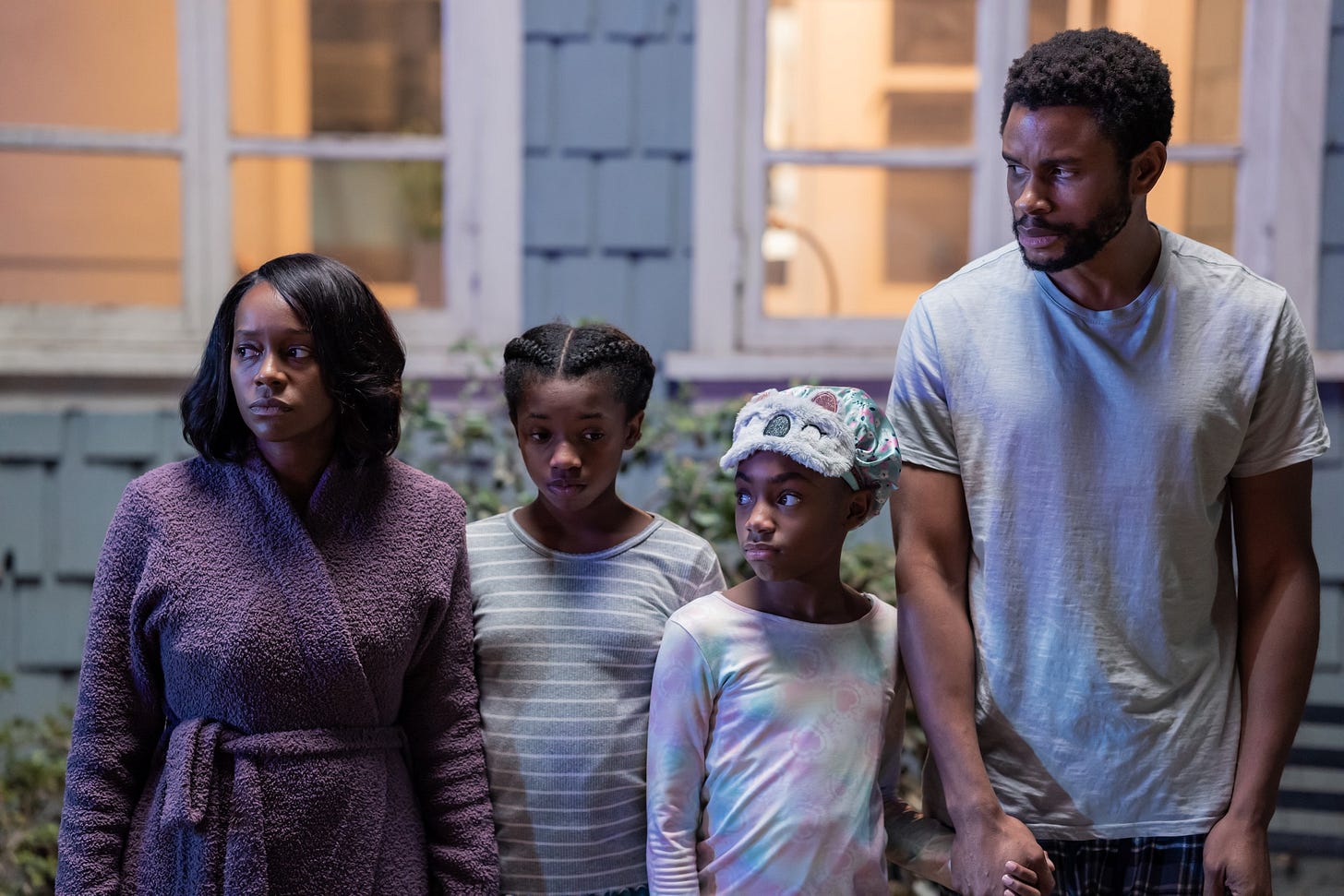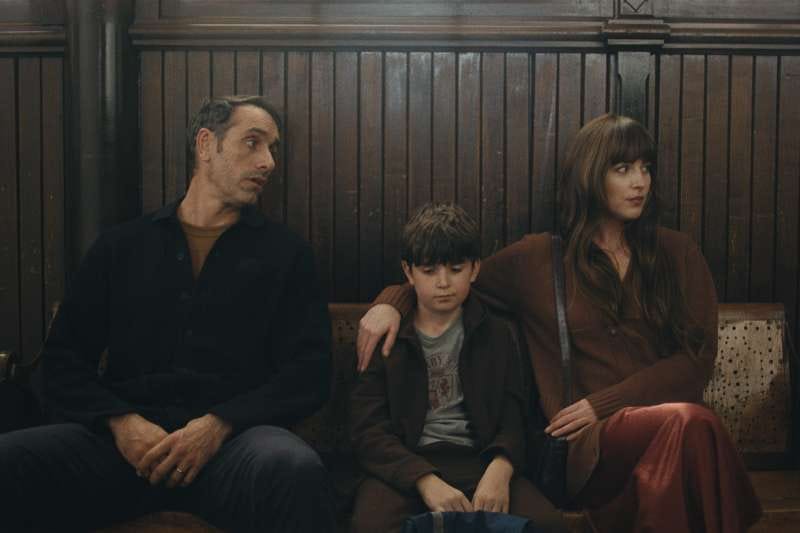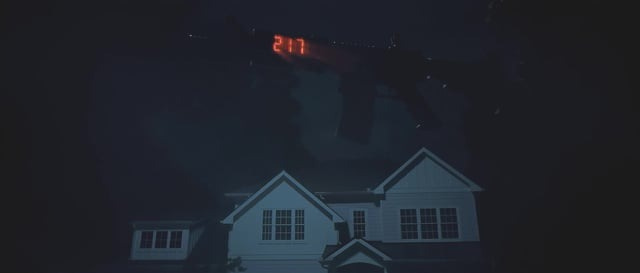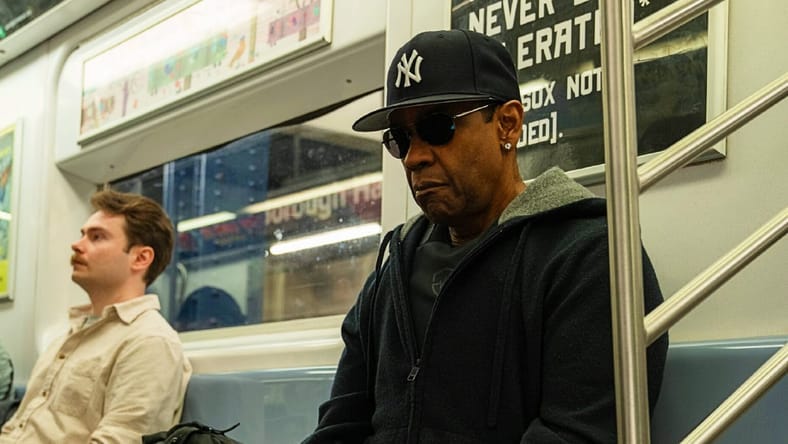Cory's Reads #48: Recession Indicators
Films are funny again, yet friends and family are falling apart...
Two recent films in 2025 offer a connection to my beloved Philadelphia Eagles.
The first is straightforward. Former Eagles CB Nnamdi Asomugha made his directorial debut with The Knife, an underseen thriller that makes up for its slight 82-minute runtime with a tight and engrossing premise. One night, Chris (Asomugha) wakes up to find an intruder in his kitchen. In his attempt to deescalate the situation, he grabs a nearby knife and kindly asks her to leave. Next thing we know, the woman is dead and the police are on their way. Did Chris kill her? Was it self-defense? Does it matter when he is a Black man and Detective Carlsen (a terrific Melissa Leo) refuses to let the night end without uncovering the so-called truth?
Asomugha may have been better off fleshing The Knife out into a miniseries for Netflix, where this genre tends to thrive, but he still manages to pack his first feature with more ideas around race, guilt, and responsibility to one’s family than comparable projects ever pull off across six or seven episodes. The former NFL All-Pro equips himself well both in front of and behind the camera, capturing moments of both tension and intimacy in dizzying close-up, the fear of losing it all slowly encroaching on Chris’ impressive sense of calm.
I first recognized Asomugha onscreen — and not in an NFL uniform — in 2022’s The Good Nurse. By then, he had already been nominated for an Independent Spirit Award for his performance in 2017’s Crown Heights, and served as an executive producer on Cary Joji Fukunaga’s 2015 war drama Beasts of No Nation. Over the last decade, Asomugha has quietly ascended through Hollywood’s ranks, most recently establishing himself as a talented multi-hyphenate with The Knife, a film I expect to find a second life on streaming. As an Eagles fan, it is likely the most excitement I have felt for the former first-round pick, whose excellence as an Oakland Raider in the first half of his career earned him spots on several All-Decade Teams in the 2000s. He is widely regarded as one of the greatest Raiders of all time, and yet Asomugha’s reputation as a shutdown corner in Oaktown could not carry over to Philadelphia, where he became the highest-priced free agent signing of the 2011 offseason. A member of the infamous “Dream Team” under head coach Andy Reid, Asomugha was waived just two years later.

The Knife has nothing to actually do with the sport of football, nor does Jay Roach’s The Roses, the second film with a connection to the Eagles, albeit in a much more tenuous capacity. In a blink-and-you’ll-miss-it shot of a hotel TV, the remake of 1989’s The War of the Roses reveals itself to be set at the exact moment the Eagles selected Northwestern QB Clayton Thorson with the 167th pick of the 2019 NFL Draft.
That’s it. That’s the connection. It’s not much, and it surely is not significant enough to merit mention in this month's newsletter, but it earns its spot as football has reemerged right on schedule as my greatest obsession.
Perhaps the Jordan Peele-produced HIM will allow me to more meaningfully have a conversation about football next month — I just watched Oliver Stone’s Any Given Sunday for the first time and am eager to unpack its scattered dissection of the sport’s institutionalized racism — but in the meantime, I am grateful for the more obvious parallels between The Knife, The Roses, and several other 2025 releases focusing on the dissolution of the family unit.
After all, what goes together more than family and football?
Decidedly different in tone from The Knife, The Roses finds a once-in-love British couple (the formidable duo of Olivia Colman and Benedict Cumberbatch) drifting apart in a variety of heartfelt and humorous ways, hurtling towards a vicious divorce and a fiery finale. While the film sometimes struggles to balance its marriage melodrama with its cringe comedy, those disparate parts are still appropriately moving and silly, and mostly cohere into a welcome update on the 1989 film, which itself was an adaptation of Warren Adler’s 1981 novel. Roach’s classical construction mirrors most other rom-coms of yesteryear, part of a broader resurrection of the studio comedy in 2025. Naked Gun is likely the most obvious bedfellow in that resurgence, but films like Friendship — hilarious if also dark and subjective — and Materialists — not remotely funny yet still indebted to the works of Woody Allen and Nora Ephron — similarly suggest a renaissance for a genre long considered a relic in the theatrical space.
Another such film is Michael Angelo Covino’s Splitsville, which shares an overwhelming degree of DNA with The Roses. This particular divorce dramedy differentiates itself with its focus on two married couples who decide to “open up” their marriages to increasingly disastrous and amusing results. It’s a decidedly sexier affair, not just because it features seductive turns from Dakota Johnson and Adria Arjona, but also because Covino, like Friendship director Andrew DeYoung, adopts a kind of arthouse sensibility in staging each fight, freakout, and fuck. Splitsville is likely my favorite of the bunch, not just for its visual prowess, but for the interest it takes in young Russ (Simon Webster) — the son of Paul (Covino) and Julie (Johnson) — and his own complicated processing of his parent’s divorce, not to mention the awkward presence of his gym teacher/father’s best friend Carey (Kyle Marvin), who just so happened to sleep with Julie after his wife Ashley (Arjona) abruptly announced her desire for a divorce. As sexual tensions rise and fall, and partners filter in and out of the foursome’s lives, Splitsville wisely checks in with Russ every now and then. How can the kid stay out of trouble at school with such chaos back home? Who could blame him for stealing a neighbor’s jet ski every now and then?
In its satirical examination of modern-day relationships and the kind of “free thinking” that mostly just enables the worst tendencies in the worst people you know, Splitsville crucially considers how such selfish and stupid adults may be harming the young people who rely on them. Protecting Russ and ensuring his bright future is nary a priority for Paul and Julie, at least not until they have no choice but to make it one. But the anxiety of protecting one’s child lingers over all of Splitsville, even at the film’s most slapstick and silly. It is an anxiety that more pointedly colors Zach Cregger’s Weapons, one of the biggest hits of the year, and a very funny movie in its own right.
You likely know the premise of Weapons by now. Its juicy Twilight Zone setup finds a small-town community in disarray after all but one child from the same grade-school classroom mysteriously vanishes in the night. At 2:17 AM, each student — sans Alex (Cary Christopher) — wakes up, walks out their front door, and runs away with their arms spread out like that chilling photo of the napalm girl in Vietnam. Their sudden disappearance may have occurred overnight, but their parents’ anger and resentment is squarely oriented towards schoolteacher Justine Gandy (Julia Garner).
Why did only her students go missing? How could she fail to keep them safe? In this way, Weapons evokes very real anxieties around school shootings.
Real-life events have already eroded our faith in educational institutions as safe havens or developmental environments, and Cregger’s new film posits an even more terrifying possibility: perhaps our communities are no longer safe, and there is nothing we can do to protect our loved ones from danger. That fear manifests itself in varying ways across the film’s ensemble, but the most unnerving segment follows Archer Graff (Josh Brolin), whose son Matthew went missing on that fateful night.
In an unforgettable nightmare sequence, Archer finds himself on his own late-night run through the small town of Maybrook, PA. In his pursuit of a mysterious woman in clown makeup, Archer stumbles upon an uncanny sight: a giant AR-15 hovering above a typical suburban home. The image is never explained, nor should it be. It has already become one of the most indelible frames of 2025, and its haunting uncertainty is a big reason why.
Archer is downtrodden, convinced he has failed as a father because he was unable to protect his son from whatever evil compelled him to disappear overnight. His subconscious conjuring of a giant assault rifle seems to further suggest that mass shootings are not far from the minds of Archer and Maybrook’s residents. Of course, the rifle is also the most literal “weapon” to appear in Weapons. True violence does not appear onscreen until much later into the film — and trust me, it arrives in a big way — but the mere suggestion of violence via Archer’s imaginary gun in the sky already positions Weapons at the forefront of 2025’s conversations around community safety and protecting one’s family. Archer may be the only onscreen father to welcome us into the shame and dread of his own personal dreamscape, but he is far from alone in his vigilant attempt to rescue his child.
Spike Lee opted to remake one of the most iconic films about a parent’s (in)ability to protect their child when he shifted Akira Kurosawa’s 1963 film High to Low to the streets of present day New York City, with 2025’s Highest 2 Lowest. Lee is one of my favorite filmmakers alive, and yet his newest project is largely unsuccessful in revisiting a story that, on the surface, feels ripe for a modern day reinterpretation. Highest 2 Lowest lacks the sociopolitical urgency that has become a calling card of Lee’s over the years, instead settling into a kind of elderly complacency towards issues of class, race, and culture. However, the film’s surprising sidestepping of its racial implications only further underscores its anxious underpinnings. Highest 2 Lowest follows wealthy record label CEO David King (Denzel Washington), who believes his son has been kidnapped, when it is revealed that Trey (Aubrey Joseph) is safe and that it is actually his best friend Kyle (Elijah Wright) — the son of David’s personal driver/confidant Paul (Jeffrey Wright) — who has been mistakenly kidnapped instead.
That convoluted setup felt effortless in 1963, yet oddly belabored over sixty years later in the hands of a director who rarely struggles to find a story’s beating heart. The fallout of the kidnapping is oddly superficial, levying little judgment towards David’s selfish handling of the situation. His goal is to retain his empire, even if it means dodging the $17.5 million ransom that Paul and Trey so desperately want him to pay. By the time David comes around to the arrangement, he just might be able to have his cake and eat it too.
Even with its saccharine storytelling and rosy resolution, Highest 2 Lowest does still lend some new dimensions to our yearlong reckoning with our own status as protectors. David’s old-school style of parenting is cold and borderline abusive. He is concerned with forging a specific kind of masculinity and strength in his son Trey, not to mention leaving him with a sizable nest egg. There is a sense that David cares most about his own personal legacy, but the film resists any true interrogation of that idea —maybe Spike is wrestling with similar questions of his own. It is no surprise that Highest 2 Lowest is the least comical film of the bunch, so certain of its own righteousness. That is disappointing for a filmmaker whose sense of fun and vivacity transcends that of almost any other.
Alas, it is satisfying to find so many different filmmakers at varying junctures in their career, all coalescing around similar preoccupations. The term “recession indicator” likely has more value as a meme than a genuine economic tool these days, but within that memeable phrase rests legitimate throughlines which may reflect a cultural — if not an economic — downturn. I believe we have identified three such indicators:
Films are about friends and families falling apart, and only sometimes coming back together. The trend is suggestive of broader instability in our lives. Economic and social anxieties have left us afraid that we may not be the protector our families need, nor the allies our friends and partners want. While rooted in some very classical tropes, the theme has reemerged in 2025 across countless films. Examples include The Knife, The Roses, Splitsville, Weapons, Highest 2 Lowest, Friendship, 28 Years Later, The Toxic Avenger, Lurker, Mission: Impossible — The Final Reckoning, The Woman in the Yard, Caught Stealing, Wolf Man, Final Destination: Bloodlines, The Fantastic Four: First Steps, Thunderbolts*, Death of a Unicorn, Together, The Life of Chuck, The Assessment, The Amateur, Jimmy & Stiggs, Relay, Eddington, Sinners, Freaky Tales, Superman, and The Phoenecian Scheme.
Films are funny! Audiences have lamented the death of the theatrical comedy for years, but 2025 has officially provided us with enough laugh-out-loud films to justify some cautious optimism for the years ahead. Of course, the return of true comedy is perhaps the most obvious “recession indicator,” signaling a societal need to push past all the anxieties outlined above and just smile. Examples include The Naked Gun, Friendship, Caught Stealing, The Roses, Splitsville, Heart Eyes, The Phoenician Scheme, Lurker, Weapons, Mickey17, The Toxic Avenger, and Eddington.
Cinema is sexy once again! Online debates around the merit of sex scenes have grown overly obnoxious and unnecessary in recent years, but 2025 has fortunately rectified recent history with a selection of films that are unafraid to bear it all. A sex-positive cinema seems to align with a viewing public that is out of fucks to give, and I for one am officially fuckless as of the fall of 2025. Examples of such films include Caught Stealing, Black Bag, The Roses, Splitsville, Together, The Knife, The Assessment, Materialists, Ballerina, and Sinners.
The sad truth is that, even with such promising parallels emerging amongst several 2025 releases, the year remains rather underwhelming on the whole. While there is a lot to love between my current holy trinity of Sinners, The Phoenician Scheme, and Eddington, I am still on the lookout for a few more great films to emerge in 2025. Fortunately, I am anticipating several. If you want to get a sense of what might be on the horizon for the rest of the year, check out my latest podcast episode of It’s All Film and Games. Very proud of this one!
And if I missed a certain recession indicator or cinematic omen, please let me know! Subscribers to Cory’s Reads can chat directly with me HERE.
Thanks for reading, and go birds.
Letterboxd Review of the Month
Loses a bit of steam in its final act when it should be upping the ante, but I still found this incredibly gripping and detailed, with an unnerving lead performance from Theodore Pellerin. Comparisons to The King of Comedy and Perfect Blue are appropriate, but I found myself thinking about Under the Silver Lake a lot while watching this, with its unromantic rendering of Los Angeles and its characters' unmoored search for meaning across that increasingly desolate landscape.
Follow me on Letterboxd at @creid61, and keep up with the rest of my work on Instagram at @coryreid6125.
I am on BlueSky now as well! Follow me at @coryreid.bsky.social.
You can also support my work over at Buy Me a Coffee.






